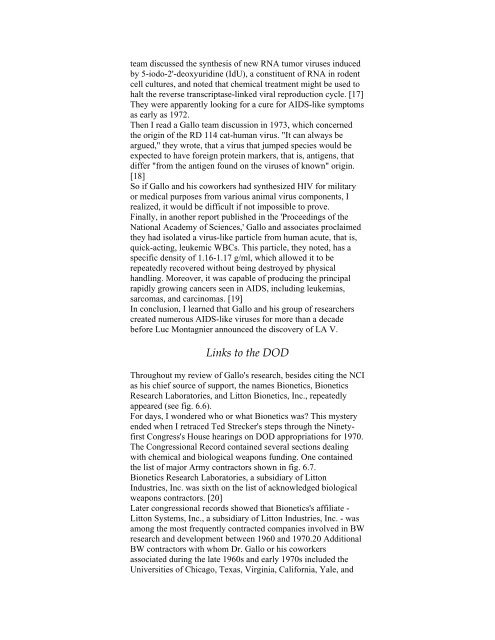Emerging Viruses-Aids & Ebola - By Leanard ... - preterhuman.net
Emerging Viruses-Aids & Ebola - By Leanard ... - preterhuman.net
Emerging Viruses-Aids & Ebola - By Leanard ... - preterhuman.net
Create successful ePaper yourself
Turn your PDF publications into a flip-book with our unique Google optimized e-Paper software.
team discussed the synthesis of new RNA tumor viruses inducedby 5-iodo-2'-deoxyuridine (IdU), a constituent of RNA in rodentcell cultures, and noted that chemical treatment might be used tohalt the reverse transcriptase-linked viral reproduction cycle. [17]They were apparently looking for a cure for AIDS-like symptomsas early as 1972.Then I read a Gallo team discussion in 1973, which concernedthe origin of the RD 114 cat-human virus. "It can always beargued," they wrote, that a virus that jumped species would beexpected to have foreign protein markers, that is, antigens, thatdiffer "from the antigen found on the viruses of known" origin.[18]So if Gallo and his coworkers had synthesized HIV for militaryor medical purposes from various animal virus components, Irealized, it would be difficult if not impossible to prove.Finally, in another report published in the 'Proceedings of theNational Academy of Sciences,' Gallo and associates proclaimedthey had isolated a virus-like particle from human acute, that is,quick-acting, leukemic WBCs. This particle, they noted, has aspecific density of 1.16-1.17 g/ml, which allowed it to berepeatedly recovered without being destroyed by physicalhandling. Moreover, it was capable of producing the principalrapidly growing cancers seen in AIDS, including leukemias,sarcomas, and carcinomas. [19]In conclusion, I learned that Gallo and his group of researcherscreated numerous AIDS-like viruses for more than a decadebefore Luc Montagnier announced the discovery of LA V.Links to the DODThroughout my review of Gallo's research, besides citing the NCIas his chief source of support, the names Bio<strong>net</strong>ics, Bio<strong>net</strong>icsResearch Laboratories, and Litton Bio<strong>net</strong>ics, Inc., repeatedlyappeared (see fig. 6.6).For days, I wondered who or what Bio<strong>net</strong>ics was? This mysteryended when I retraced Ted Strecker's steps through the Ni<strong>net</strong>yfirstCongress's House hearings on DOD appropriations for 1970.The Congressional Record contained several sections dealingwith chemical and biological weapons funding. One containedthe list of major Army contractors shown in fig. 6.7.Bio<strong>net</strong>ics Research Laboratories, a subsidiary of LittonIndustries, Inc. was sixth on the list of acknowledged biologicalweapons contractors. [20]Later congressional records showed that Bio<strong>net</strong>ics's affiliate -Litton Systems, Inc., a subsidiary of Litton Industries, Inc. - wasamong the most frequently contracted companies involved in BWresearch and development between 1960 and 1970.20 AdditionalBW contractors with whom Dr. Gallo or his coworkersassociated during the late 1960s and early 1970s included theUniversities of Chicago, Texas, Virginia, California, Yale, and








![The Big Lie 9-11 and Government Complicity in Mass Murder [PDF]](https://img.yumpu.com/50957077/1/190x245/the-big-lie-9-11-and-government-complicity-in-mass-murder-pdf.jpg?quality=85)







